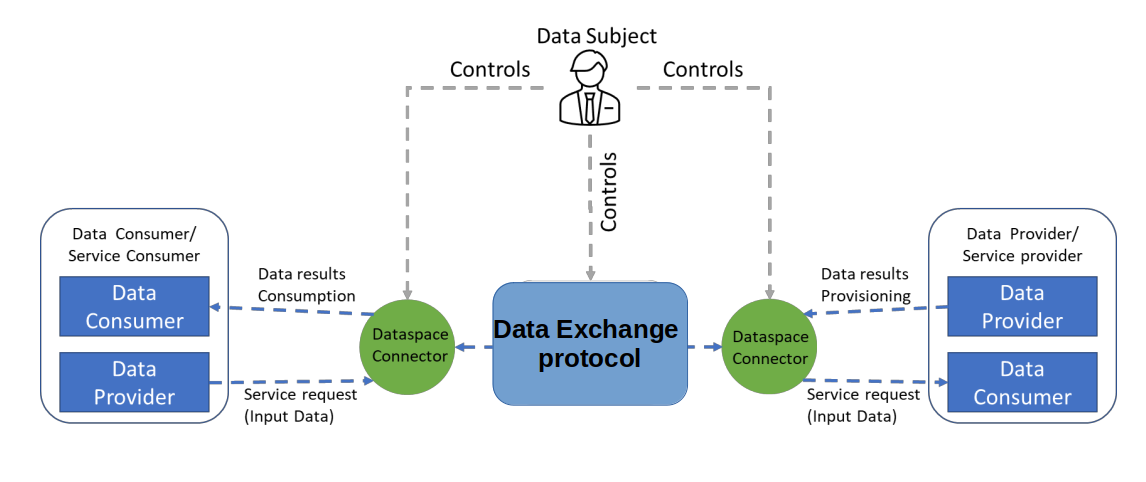FOR SHARE - JULY SNAPSHOT - Data Exchange - Two pages descriptions
Early draft
Please be aware that the Data Spaces Blueprint content shared in these pages are a very early draft published on 2023-07-01. The current draft is incomplete and the content might still change.
SAVE-THE-DATE 01-10/09/2023: We will welcome your feedbacks to future improve the Data Spaces Blueprint during the Public consultation that will open on September the 1st 2023 until September the 10th. Please mark these dates in your calendar and get ready!
Overview
To enable data exchange between participants within a data space and across data spaces, some agreed data exchange protocols are needed. This Building Block will propose the optimized set of protocols to maximize interoperability in a particular data space.
In some domains, concrete data exchange APIs have been established by regulation or as the “de facto” standard for exchange among different organizations and this situation will be allowed. This Building Block will propose the minimum viable set of data exchange APIs that can be adopted as data exchange protocols within domains that do not dictate any and will enable interoperability cross-domain within a data space or among data spaces. These minimum viable data exchange APIs should be domain-agnostic.
Ideally, the fewer the protocols the easier the interchange, because multi-protocol situations lead to higher complexity and slower adoption. Besides this, naturally, the market tends to simplify into a few ones. It is also true that in some very specific situations, some specific application protocols could be needed. Besides this de DSBA technical convergence document explicitly mention that the proposed data transfer protocol will be NGSI-LD.
Data exchange protocols are a set of rules and guidelines that govern the exchange of data between two or more components in a particular domain or application.
Recall that the other building block ‘Data Models and Formats’ describes the modeling of the knowledge and information within the considered domain by describing which information plays what role. Data exchange building block, on the other hand, is about describing how these semantic data models are used in the interaction between systems, and/or data members, and between systems themselves. It is therefore that data space initiatives must adhere to a widely accepted protocol that enables communication between different devices or applications without imposing relevant restrictions on how the information should be structured. By standardizing the communication protocols a data space initiative can set the first step towards interoperability.
This building block will provide guidelines and technical specifications about common communication protocols that all data space roles can use to exchange standardized data. This building block enables a proper exchange of data.
Key elements
Data Exchange Protocols: Define the format, timing, and error handling mechanisms required for data transmission between systems. (Examples may include NGSI-LD, proposed by DSBA, HTTP, Websockets, and MQTT)
Meta specifications and best practices
Open standards to specify and formalize the data exchange protocols including OAS, SPARQL, GraphQL, Linked Data Platform
Design rules: e.g. REST API design rules, OpenAPI Naming and Design Rules | UNECE …
The validation service supports during the development phase of connecting to a data space and can also be used for certification of implementations on the data level (syntax).
Key functions
A list of the main functions that the building block needs to fulfill, along with a brief description of each function.
Function 1: Efficient transmission of data
Function 2: Allow querying and geoquerying for the different data with complex needs and different data structures
Function 3: Data streaming endpoints to receive real-time continuous streams of data.
Function 4: Data retrieval endpoints to request datasets such as historical data stored in a database
Function 5: Data query endpoints to perform queries on transactional databases or object stores.
Function 6: Data transformation endpoints to perform pre-processing or filtering operations on the data before retrieving it.
Function 7: Allow alerts on updates or modifications of the data sources
Function 8: Allow the retrieval of information on federation scenarios
Relevance for the data space
This building block allows the transport of the data between the participants in the data space once having the right permissions according to the trusted exchange building blocks. It will include methods for querying the data and for their transfer, and, eventually, for its update, deletion, etc.
